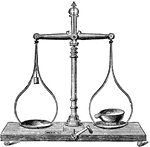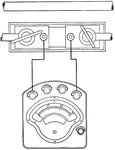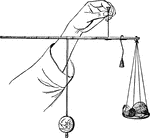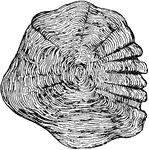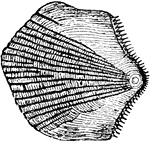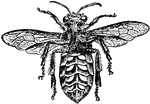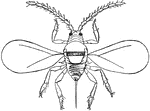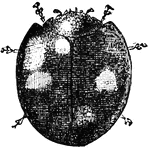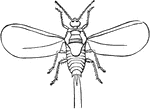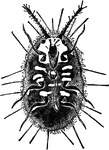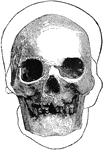
Hochelagan Skull
A front view of a Hochelagan skull, surrounded by the outline, on a larger scale, of the Cromagnon skull.
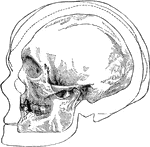
Skull
The outer outline is that of the skull found in the cave of Cromagnon, in France, belogning, as Dawson…

Black Scale
A drawing of the newly hatched larva, viewed from beneath, with enlargements of anal extremity viewed…
Barometer
"The barometer is simply a pressure gauge that registers the pressure of the air. In this case the cup…
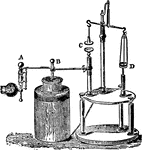
Disc Electrometer
"C is an insulated disc, over which is suspended another disc, hung from the arm of a balance, and connected…

Astatic Multiplier
"The coil is of flat, rectangular shape, with a narrow central opening just large enough to allow one…

Thomsons Galvonometer
"A very convenient form of Thomson's galvanometer, the only specimen of its kind we have seen. The peculiarity…

Leslies Hygrometer
"Leslie's hygrometer, which is an adaptation of his differential thermometer, is formed by uniting two…

Roach Scale Arrangement
"Arrangement of scales in the Roach (Leuciscus rutilus). L, Lateral line; t r, transverse line; a, transverse…

Soda Water
"Carbonic acid water, generally spoken of as Sodawater, though it seldom contains any soda. It is prepared…

Soda Water
"Carbonic acid water, generally spoken of as Sodawater, though it seldom contains any soda. It is prepared…
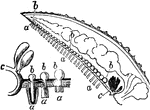
Ambulacra
"Ambulacra of Star-fish, As seen in a longitudinal and vertical section of one of the rays; and three…

Arbor Vitae
"A genus of plants of the natural order Coniferae, allied to the cypress, and consisting of evergreen…
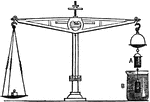
Archimedes Principle
"States that: A body when immersed in a fluid loses exactly as much of its weight as is equal to the…
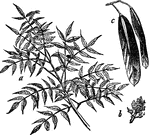
Common Ash
"Common Ash. a, a branch with leaves; b, flowers; c, fruit (on a considerably larger scale than the…
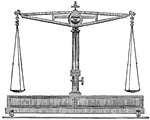
Balance
"A representation of a common form of the delicate balances employed in physical and chemical researches.…

Steelyard
"The Steelyard is more portable then the ordinary balance. It consists of a lever, AB, moving round…
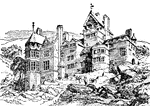
Cragside
"In domestic architecture the tendency has been to quit picturesque irregularity for a more formal and…
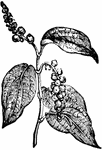
Black Pepper
"A genus of order Piperaceae. The Piper nigrum, which furnishes the black pepper of commerse, is a native…

Atwood's Machine
"Atwood's Machine. This difficulty has however been overcome by a curious piece of machinery invented…
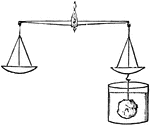
Water Weighing
"Take a piece of ivory, or any other substance that will sink in water, and weigh it accurately in the…
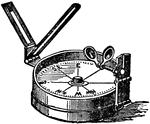
Azimuth Compass
"At sea the declination is generally observed by means of an azimuth compass invented by Kater. It consists…

Heliometer
"The type of instrument which resulted from Russian labors. The brass tube, strengthened at the bearing…

Danish Balance
A weighing apparatus somewhat resembling the steelyard, but differing from it by having the fulcrum…
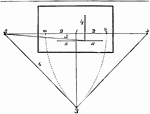
Angular Perspective
This figure comprises the whole of the points and lines preparatory to beginning a drawing in "angular…

Angular Perspective
The perspective in this plate is "angular perspective," and the figure it represents is a flat square…
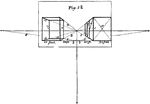
Parallel Perspective
Two upright oblong figures are here represented in parallel perspective. They may be imagined to resemble…

Angular Perspective
This object is a cube, having therefore all its faces of equal dimensions; and as both sides recede,…

Angular Perspective
This cube has four additional cubes of equal dimensions. This is effected by first drawing the cube…

Angular Perspective
This figure differs from the others because they are solid cubes. Further, the geometrical scale is…
White Lily
A ground leaf of White Lily, its base (cut across) thickened into a bulb-scale. This plainly shows that…

Low Sweet Buckeye
Series of bud-scales and foliage-leaves from a developing bud of the Low Sweet Buckeye, showing nearly…
Pitch Pine
Piece of a branch of Pitch Pine, with three leaves in a fascicle or bundle, in the axial of a thin scale,…
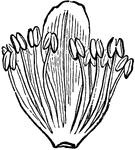
American Linden
One of five stamen-clusters of the flower of American Linden, with accompanying scale.

Pitch Pine Seed
Inside view of a separated scale or open carpel of a Pitch Pine cone with a seed in place.

Planthopper
Otiocerus coquebertii, a small insect of a somewhat elongated form and having a small projection in…
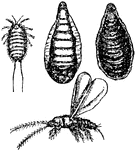
Aspidiotus Citricola
Scale-insect, was found on imported lemons in Jacksonville, Fla. This insect is said to be allied to…
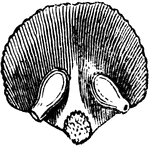
Pistil
A pistil, that is, a scale of the cone, of a Larch, at the time of flowering; inside view, showing its…

Arbor-Vitae
Branchlet of the American Arbor-Vitae, considerably larger than in nature, terminated by its pistillate…
